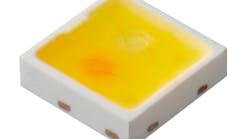The general mood was optimistic, notwithstanding the warning to the meeting by Professor Wang N. Wang, leader of Bath University’s Wide Band Gap Semiconductors Group, that “a hindrance to growth in performance and potential sales of LEDs and PV technologies is raw materials – gallium and indium resources on earth could be exhausted in five to 10 years.” Assuming these materials can still be dug out in adequate quantities – or, more likely, if organic replacements deliver – then the world will see a proliferation of both scientific and consumer-focused LED and PV applications.
Lighting designers
Giulio Antonutto, Lighting Associate with Arup, described the key LED-based solid-state-lighting (SSL) problems that remain to be solved. “We need to achieve a more aesthetic, even distribution of light so that the viewer does not see point sources,” he said. “Also, when one element of a multi-LED source fails today the whole unit needs to be replaced. Such designs are waste of money and present recycling problems. The problem of temperature management persists, as does colour rendering.”
Antonutto predicted that if this last problem can solved then “the whole face of the urban lit environment could be changed.” His provocative visuals featured brightly, colourfully illuminated cities of the future – in which the electricity bill would somehow become a trifle.
Arup’s own recent straw poll of 15 key lighting designers revealed current development priorities for LED-based lighting: quality of light including color rendering and temperature; evenness of light distribution; output; associated costs; temperature management and finally ease of maintenance, presumably last because SSL units of the future would last longer – maybe forever. Arup is also “excited” about the potential for organic LEDs, said Antonutto.
In-house lighting
Photonstar LED’s CEO James McKenzie, fresh from the recent acquisition of Enfis, asserted that LED lighting is now commercially viable and predicted to take off. He cited a recent JP Morgan forecast that LED penetration rates into the general illumination market could be at least 50% as soon as 2015. He added that LEDs are rapidly becoming the most efficient lighting source available – performance is growing steeply while the luminous efficacies of other sources (sodium, metal halide, fluorescent and halogen) are flat-lining.
McKenzie also described Photonstar LED’s involvement with last year’s Nottingham Home Optimising the Use of Solar Energy (HOUSE) project, which competed successfully in the Solar Decathlon Europe Competition in Madrid. The Nottingham HOUSE, which featured Photonstar’s LED lighting, was ranked highly for its environmental credentials, coming a close second (out of 17 international competitors) in the sustainability category.
Photonstar LED’s research into HOUSE’s LED lighting performance revealed that: uniform (LED) light levels were 27% brighter than CFL; a low-voltage LED lighting system running on 24 Vdc requires 72% less power than CFL; and overall power and storage equipment cost is dramatically reduced. Furthermore, no inverter was required for the lighting, and capital costs for both LED and CFL lighting were the same.
McKenzie commented, “We’re going to have to get used to the fact that LEDs are the future – everything else is being banned. In just a few years, we will see 200 lm/W LEDs, which is not quite as good as today’s high-pressure sodium sources – but still pretty good.”
Joking that the most efficient use of power in lighting is when a lamp is off, McKenzie added that the best way to optimize LED lighting would be by removing conversion losses in the electricity-to-light transformation. “LEDs already offer higher brightness than CFL lighting – and with 72% less power consumed,” he said. “Typically, today, the LED power demand is 3.9W/m2/100 lux while the CFL equivalent is 13.9 W/m2/100 lux.”
Solar-powered LED signboards
Zeta, a commercial spinout from Oxford Brookes University, encompasses research, design, applications engineering, production and installation, and now employs 18 staff members. Zeta’s focus is based on the twin pillars of industrial LED lighting and solar power. Commercial developments in recent years have included solar-powered illuminated “monoliths” (signboards) for roadside and public information applications. PV technology charges the monoliths’ batteries; light-guide panels provide back illumination for maps/advertising.
Installed examples already located in “Legible Leeds,” “Legible London” and Glasgow information points. Besides these, the company has branched out into illuminated bus shelters – photovoltaic technologies on the roof powering LED lighting for people waiting.
Paul Tyrell, Zeta’s technical director, commented: “Our LED-based information posts and signs are characterized by very low power consumption; zero maintenance; long life; no need for mains connection – and so they are ideal for rural locations. A key issue is designing these products so that they aren’t too attractive to reduce the chance of them being stolen.”
One of Tyrell’s other complaints concerned other developers’ shoddily-produced LED-based lighting systems “that are giving LED technology a bad name.” Was this a bit of gamesmanship, just knocking the competition arising from poor quality imports? Apparently not. “When Zeta got into the solar-powered bus-stop business there were six competitors, but now they have all fallen by the wayside,” he added. One of the keys to Zeta’s success was ensuring that its products would enjoy a long working life. "Customers are increasingly specifying a 10-year operational life and Zeta’s innovations and record management allow us to see how power usage and design maximize lifetime.”
Read Part 2: Photovoltaics in the UK, European SSL projects and LED improvement targets.




